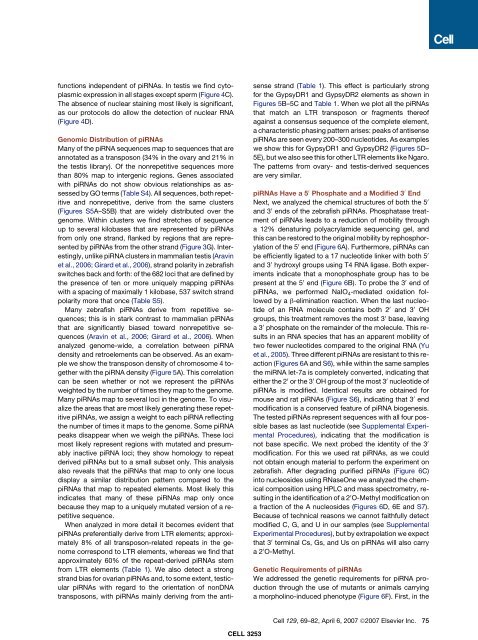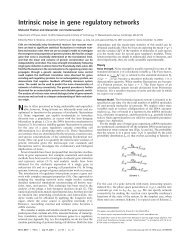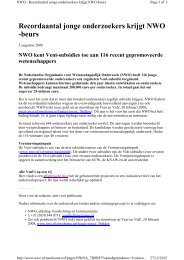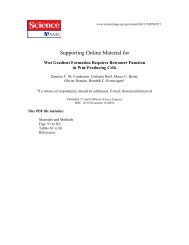A Role for Piwi and piRNAs in Germ Cell ... - Hubrecht Institute
A Role for Piwi and piRNAs in Germ Cell ... - Hubrecht Institute
A Role for Piwi and piRNAs in Germ Cell ... - Hubrecht Institute
Create successful ePaper yourself
Turn your PDF publications into a flip-book with our unique Google optimized e-Paper software.
functions <strong>in</strong>dependent of <strong>piRNAs</strong>. In testis we f<strong>in</strong>d cytoplasmic<br />
expression <strong>in</strong> all stages except sperm (Figure 4C).<br />
The absence of nuclear sta<strong>in</strong><strong>in</strong>g most likely is significant,<br />
as our protocols do allow the detection of nuclear RNA<br />
(Figure 4D).<br />
Genomic Distribution of <strong>piRNAs</strong><br />
Many of the piRNA sequences map to sequences that are<br />
annotated as a transposon (34% <strong>in</strong> the ovary <strong>and</strong> 21% <strong>in</strong><br />
the testis library). Of the nonrepetitive sequences more<br />
than 80% map to <strong>in</strong>tergenic regions. Genes associated<br />
with <strong>piRNAs</strong> do not show obvious relationships as assessed<br />
by GO terms (Table S4). All sequences, both repetitive<br />
<strong>and</strong> nonrepetitive, derive from the same clusters<br />
(Figures S5A–S5B) that are widely distributed over the<br />
genome. With<strong>in</strong> clusters we f<strong>in</strong>d stretches of sequence<br />
up to several kilobases that are represented by <strong>piRNAs</strong><br />
from only one str<strong>and</strong>, flanked by regions that are represented<br />
by <strong>piRNAs</strong> from the other str<strong>and</strong> (Figure 3G). Interest<strong>in</strong>gly,<br />
unlike piRNA clusters <strong>in</strong> mammalian testis (Arav<strong>in</strong><br />
et al., 2006; Girard et al., 2006), str<strong>and</strong> polarity <strong>in</strong> zebrafish<br />
switches back <strong>and</strong> <strong>for</strong>th: of the 682 loci that are def<strong>in</strong>ed by<br />
the presence of ten or more uniquely mapp<strong>in</strong>g <strong>piRNAs</strong><br />
with a spac<strong>in</strong>g of maximally 1 kilobase, 537 switch str<strong>and</strong><br />
polarity more that once (Table S5).<br />
Many zebrafish <strong>piRNAs</strong> derive from repetitive sequences;<br />
this is <strong>in</strong> stark contrast to mammalian <strong>piRNAs</strong><br />
that are significantly biased toward nonrepetitive sequences<br />
(Arav<strong>in</strong> et al., 2006; Girard et al., 2006). When<br />
analyzed genome-wide, a correlation between piRNA<br />
density <strong>and</strong> retroelements can be observed. As an example<br />
we show the transposon density of chromosome 4 together<br />
with the piRNA density (Figure 5A). This correlation<br />
can be seen whether or not we represent the <strong>piRNAs</strong><br />
weighted by the number of times they map to the genome.<br />
Many <strong>piRNAs</strong> map to several loci <strong>in</strong> the genome. To visualize<br />
the areas that are most likely generat<strong>in</strong>g these repetitive<br />
<strong>piRNAs</strong>, we assign a weight to each piRNA reflect<strong>in</strong>g<br />
the number of times it maps to the genome. Some piRNA<br />
peaks disappear when we weigh the <strong>piRNAs</strong>. These loci<br />
most likely represent regions with mutated <strong>and</strong> presumably<br />
<strong>in</strong>active piRNA loci; they show homology to repeat<br />
derived <strong>piRNAs</strong> but to a small subset only. This analysis<br />
also reveals that the <strong>piRNAs</strong> that map to only one locus<br />
display a similar distribution pattern compared to the<br />
<strong>piRNAs</strong> that map to repeated elements. Most likely this<br />
<strong>in</strong>dicates that many of these <strong>piRNAs</strong> map only once<br />
because they map to a uniquely mutated version of a repetitive<br />
sequence.<br />
When analyzed <strong>in</strong> more detail it becomes evident that<br />
<strong>piRNAs</strong> preferentially derive from LTR elements; approximately<br />
8% of all transposon-related repeats <strong>in</strong> the genome<br />
correspond to LTR elements, whereas we f<strong>in</strong>d that<br />
approximately 60% of the repeat-derived <strong>piRNAs</strong> stem<br />
from LTR elements (Table 1). We also detect a strong<br />
str<strong>and</strong> bias <strong>for</strong> ovarian <strong>piRNAs</strong> <strong>and</strong>, to some extent, testicular<br />
<strong>piRNAs</strong> with regard to the orientation of nonDNA<br />
transposons, with <strong>piRNAs</strong> ma<strong>in</strong>ly deriv<strong>in</strong>g from the anti-<br />
CELL 3253<br />
sense str<strong>and</strong> (Table 1). This effect is particularly strong<br />
<strong>for</strong> the GypsyDR1 <strong>and</strong> GypsyDR2 elements as shown <strong>in</strong><br />
Figures 5B–5C <strong>and</strong> Table 1. When we plot all the <strong>piRNAs</strong><br />
that match an LTR transposon or fragments thereof<br />
aga<strong>in</strong>st a consensus sequence of the complete element,<br />
a characteristic phas<strong>in</strong>g pattern arises: peaks of antisense<br />
<strong>piRNAs</strong> are seen every 200–300 nucleotides. As examples<br />
we show this <strong>for</strong> GypsyDR1 <strong>and</strong> GypsyDR2 (Figures 5D–<br />
5E), but we also see this <strong>for</strong> other LTR elements like Ngaro.<br />
The patterns from ovary- <strong>and</strong> testis-derived sequences<br />
are very similar.<br />
<strong>piRNAs</strong> Have a 5 0 Phosphate <strong>and</strong> a Modified 3 0 End<br />
Next, we analyzed the chemical structures of both the 5 0<br />
<strong>and</strong> 3 0 ends of the zebrafish <strong>piRNAs</strong>. Phosphatase treatment<br />
of <strong>piRNAs</strong> leads to a reduction of mobility through<br />
a 12% denatur<strong>in</strong>g polyacrylamide sequenc<strong>in</strong>g gel, <strong>and</strong><br />
this can be restored to the orig<strong>in</strong>al mobility by rephosphorylation<br />
of the 5 0 end (Figure 6A). Furthermore, <strong>piRNAs</strong> can<br />
be efficiently ligated to a 17 nucleotide l<strong>in</strong>ker with both 5 0<br />
<strong>and</strong> 3 0 hydroxyl groups us<strong>in</strong>g T4 RNA ligase. Both experiments<br />
<strong>in</strong>dicate that a monophosphate group has to be<br />
present at the 5 0 end (Figure 6B). To probe the 3 0 end of<br />
<strong>piRNAs</strong>, we per<strong>for</strong>med NaIO 4-mediated oxidation followed<br />
by a b-elim<strong>in</strong>ation reaction. When the last nucleotide<br />
of an RNA molecule conta<strong>in</strong>s both 2 0 <strong>and</strong> 3 0 OH<br />
groups, this treatment removes the most 3 0 base, leav<strong>in</strong>g<br />
a 3 0 phosphate on the rema<strong>in</strong>der of the molecule. This results<br />
<strong>in</strong> an RNA species that has an apparent mobility of<br />
two fewer nucleotides compared to the orig<strong>in</strong>al RNA (Yu<br />
et al., 2005). Three different <strong>piRNAs</strong> are resistant to this reaction<br />
(Figures 6A <strong>and</strong> S6), while with<strong>in</strong> the same samples<br />
the miRNA let-7a is completely converted, <strong>in</strong>dicat<strong>in</strong>g that<br />
either the 2 0 or the 3 0 OH group of the most 3 0 nucleotide of<br />
<strong>piRNAs</strong> is modified. Identical results are obta<strong>in</strong>ed <strong>for</strong><br />
mouse <strong>and</strong> rat <strong>piRNAs</strong> (Figure S6), <strong>in</strong>dicat<strong>in</strong>g that 3 0 end<br />
modification is a conserved feature of piRNA biogenesis.<br />
The tested <strong>piRNAs</strong> represent sequences with all four possible<br />
bases as last nucleotide (see Supplemental Experimental<br />
Procedures), <strong>in</strong>dicat<strong>in</strong>g that the modification is<br />
not base specific. We next probed the identity of the 3 0<br />
modification. For this we used rat <strong>piRNAs</strong>, as we could<br />
not obta<strong>in</strong> enough material to per<strong>for</strong>m the experiment on<br />
zebrafish. After degrad<strong>in</strong>g purified <strong>piRNAs</strong> (Figure 6C)<br />
<strong>in</strong>to nucleosides us<strong>in</strong>g RNaseOne we analyzed the chemical<br />
composition us<strong>in</strong>g HPLC <strong>and</strong> mass spectrometry, result<strong>in</strong>g<br />
<strong>in</strong> the identification of a 2 0 O-Methyl modification on<br />
a fraction of the A nucleosides (Figures 6D, 6E <strong>and</strong> S7).<br />
Because of technical reasons we cannot faithfully detect<br />
modified C, G, <strong>and</strong> U <strong>in</strong> our samples (see Supplemental<br />
Experimental Procedures), but by extrapolation we expect<br />
that 3 0 term<strong>in</strong>al Cs, Gs, <strong>and</strong> Us on <strong>piRNAs</strong> will also carry<br />
a 2 0 O-Methyl.<br />
Genetic Requirements of <strong>piRNAs</strong><br />
We addressed the genetic requirements <strong>for</strong> piRNA production<br />
through the use of mutants or animals carry<strong>in</strong>g<br />
a morphol<strong>in</strong>o-<strong>in</strong>duced phenotype (Figure 6F). First, <strong>in</strong> the<br />
<strong>Cell</strong> 129, 69–82, April 6, 2007 ª2007 Elsevier Inc. 75






